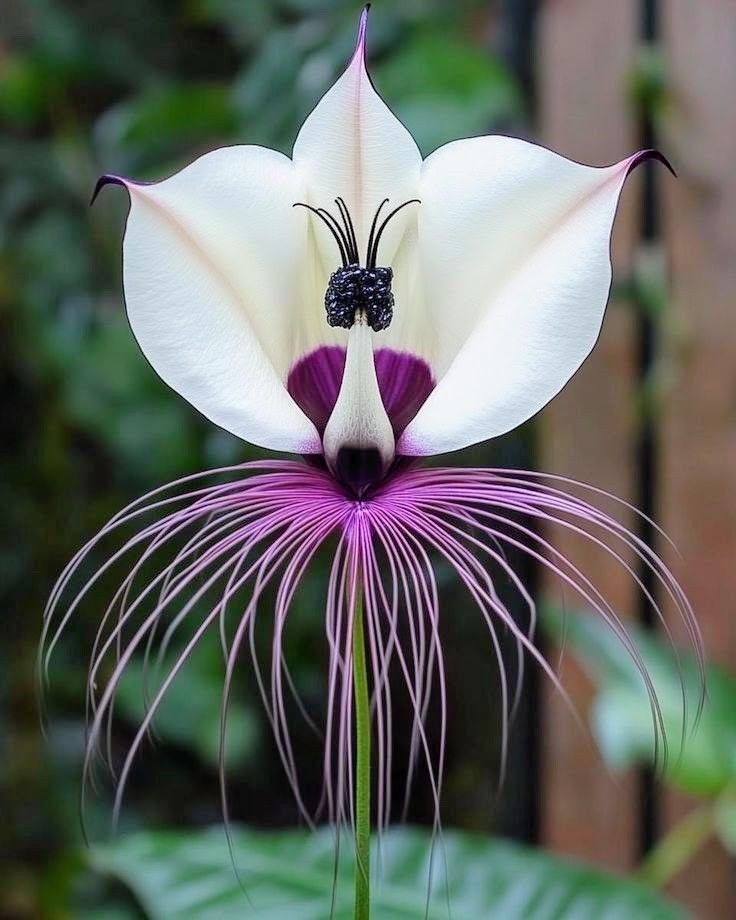The Black Bat Flower (Tacca integrifolia) is one of the most intriguing and exotic plants you can find. With its striking appearance, it has earned its name for the dark, bat-like shape of its flowers, complete with long, whisker-like filaments extending from the petals, creating a truly otherworldly look. Native to Southeast Asia, this tropical plant is a favorite for collectors and enthusiasts of unique and rare plants. Let’s dive into how to grow and care for this fascinating flower.
Key Growing Conditions
Light: Bright, indirect light
While the Black Bat Flower can tolerate some shade, it thrives best in bright, indirect light. Too much direct sunlight can scorch its delicate foliage and stunt its growth, so it’s ideal to place it in a spot with filtered light, such as near a window with sheer curtains. Outdoors, it should be grown under the shade of taller plants or trees.
Water: Consistently moist soil
The Black Bat Flower prefers consistently moist soil but doesn’t tolerate waterlogging. It’s essential to keep the soil well-draining, so it doesn’t retain too much water, which can lead to root rot. Water the plant thoroughly when the soil feels dry to the touch, and always ensure the pot has proper drainage if grown indoors.
Soil: Rich, well-draining, and slightly acidic soil
For optimal growth, the Black Bat Flower needs a rich, loamy soil mix that drains well while retaining some moisture. It thrives in slightly acidic soil with a pH of 5.5 to 6.5. If you’re planting it in a pot, a well-draining potting mix with some added perlite or coarse sand can provide the ideal conditions.
Temperature: Warm, humid conditions (65-85°F / 18-29°C)
The Black Bat Flower thrives in warm temperatures, ideally between 65°F and 85°F (18°C to 29°C). It doesn’t tolerate cold well, so it should be kept indoors in cooler climates or during the winter months. In tropical climates, it can be grown outdoors, but frost will harm the plant.
Humidity: High humidity preferred
As a tropical plant, the Black Bat Flower needs high humidity to thrive. It’s best suited to areas where humidity levels are consistently above 50%. If you’re growing it indoors, consider using a humidifier, placing the plant on a humidity tray, or regularly misting the leaves. Grouping multiple plants together can also help create a more humid environment.
Care and Maintenance
Fertilization: Feed during the growing season
The Black Bat Flower benefits from a balanced liquid fertilizer during the growing season (spring and summer). Fertilize every 4-6 weeks with a diluted, balanced fertilizer to encourage strong growth and vibrant blooms. In the fall and winter, you can reduce feeding as the plant’s growth slows down.
Pruning: Remove dead or yellowing leaves
Regular pruning can help keep the Black Bat Flower healthy and attractive. Remove any yellowing or dead leaves to prevent pests and disease from taking hold. This also encourages new growth and helps maintain a neat appearance. Pruning spent flowers can also promote further blooming.
Repotting: Repot every 2-3 years
The Black Bat Flower is a slow-growing plant, but it will eventually need to be repotted when its roots outgrow the current container. Repotting every 2 to 3 years is typically sufficient. Choose a pot that is only slightly larger than the current one to avoid excess water retention in the soil.
Common Problems and Solutions
Pests: Aphids, spider mites, and mealybugs
While relatively pest-resistant, the Black Bat Flower can sometimes attract pests like aphids, spider mites, and mealybugs. Regularly inspect your plant for any signs of infestation, such as webbing or sticky residue. If you spot pests, gently wipe them off with a damp cloth or spray the plant with an insecticidal soap or neem oil solution.
Diseases: Fungal infections and root rot
Root rot is a common issue when the Black Bat Flower is overwatered or if the soil doesn’t drain well. To prevent this, ensure the plant is grown in well-draining soil and that the pot has sufficient drainage. If you notice yellowing leaves or wilting, check the roots for signs of rot. Fungus and mildew can also affect this plant, so ensure it has good airflow and that the leaves aren’t consistently wet.
Yellowing leaves: Overwatering or low light
Yellowing leaves can be a sign of either overwatering or insufficient light. Check the soil’s moisture level and make sure the plant is in an area with the proper amount of light. If overwatering is the issue, let the soil dry out a little before watering again.
Special Care Tips
Support for flowers: Provide light staking
The long, whisker-like filaments that extend from the Black Bat Flower’s blooms are quite delicate. To prevent these from breaking, you may want to provide some light staking or support to help keep the flowers upright, especially if the plant is growing in a pot where wind and drafts can affect its structure.
Proper spacing: Give it room to grow
When growing the Black Bat Flower, it’s essential to give it plenty of space to spread out. In its native environment, it grows as a shrub-like plant, so be sure to plant it with adequate spacing to allow for healthy growth. This is especially important if you’re growing it outdoors in a tropical garden or greenhouse.
Conclusion
The Black Bat Flower (Tacca integrifolia) is a captivating and rare tropical plant that can make an exceptional addition to any garden or indoor space. With its unique, dark bat-like blooms, it’s sure to be a conversation starter. While it does require specific growing conditions, such as warm temperatures, high humidity, and well-draining soil, its beauty and fascinating appearance make it well worth the effort. Whether grown in a greenhouse, on a balcony, or as part of a tropical garden, the Black Bat Flower is sure to impress with its mysterious and exotic charm.
More Articles You Might Like
-
Texas Toast Sloppy Joes: The Crunchy, Cheesy Upgrade You Didn’t Know You Needed
There’s something timeless about sloppy joes. For generations, this saucy, savory, and slightly sweet ground beef sandwich has been a go-to comfort food in American kitchens. It’s quick, filling, and family-friendly—perfect for busy weeknights. But what if we told you there’s a way to take this classic dish up a notch? Enter the Texas Toast…
-
Classic Pig Pickin’ Cake
When it comes to Southern desserts, few sweets shine as brightly as the Classic Pig Pickin’ Cake. This nostalgic cake, sometimes called a “Mandarin Orange Cake,” has roots deep in Southern tradition. It gets its playful name from its frequent appearance at pig pickin’s—Southern-style barbecue gatherings where communities come together to enjoy slow-cooked pork, sides,…
-
Lemon Garlic Butter Chicken with Creamy Parmesan Pasta
There’s something irresistible about the combination of tender, golden-browned chicken paired with a creamy pasta coated in Parmesan cheese. Add the brightness of lemon, the depth of garlic, and the richness of butter, and you have a recipe that feels indulgent yet approachable enough for a weeknight dinner. Lemon Garlic Butter Chicken with Creamy Parmesan…



